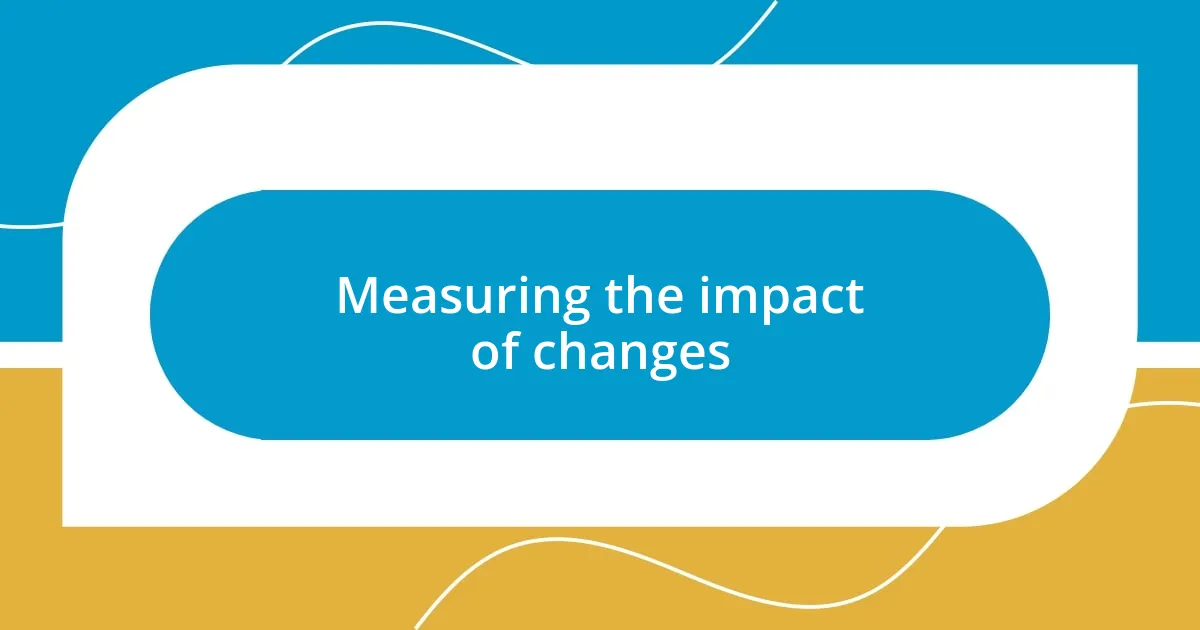Key takeaways:
- Feedback is essential for growth, revealing blind spots and improving client relationships.
- Collecting feedback effectively is best achieved through personal interactions and real-time assessments.
- Implementing feedback doesn’t require major changes; small adjustments can lead to significant improvements.
- Measuring the impact of changes through both quantitative and qualitative metrics enhances understanding and client satisfaction.

Understanding the importance of feedback
Feedback is a powerful tool that can shine a light on blind spots we may not even realize we have. I still remember a time when a client pointed out a misalignment in our expectations. That single piece of feedback changed how I approached future projects; it made me more proactive in clarifying goals upfront.
When I reflect on the moments I’ve taken feedback to heart, it’s clear how pivotal those conversations have been for my growth. Have you ever had that eye-opening realization from a client’s comments? I find that these insights often lead to creative breakthroughs and enhance the overall quality of my work. The emotional weight of that experience pushed me to embrace feedback more openly, recognizing it as a catalyst for improvement.
Moreover, feedback creates a deeper connection with clients, showing them that their opinions are valued. I’ve noticed when clients feel heard, the relationship transforms; there’s a sense of partnership instead of mere transactional interaction. Isn’t it fascinating how this dialogue can elevate not just our work but also our relationship with those we serve? Embracing feedback is truly a journey worth taking.

Collecting feedback effectively
Collecting feedback effectively involves creating an environment where clients feel comfortable sharing their thoughts. I recall a situation where I sent out a simple survey to clients after completing a project, but I noticed the response rate was low. So, I decided to schedule one-on-one calls instead. Those conversations revealed rich insights that surveys often miss. Isn’t it amazing how personal interaction can bridge gaps that forms can’t?
In my experience, timing is crucial. I’ve learned to ask for feedback not just at the end of a project but at various stages along the way. This approach allows me to course-correct and make adjustments in real-time. For instance, during a recent project, I actively sought client input after each milestone. The result? Enhanced satisfaction and improved results. Has this ever happened to you, where early feedback made all the difference?
Lastly, the medium through which feedback is collected can significantly affect its quality. I’ve experimented with different methods, from email to video calls. Each has its strengths, but I’ve found that casual chats often yield the most genuine reactions. They create an informal atmosphere where clients feel less pressure to sugarcoat their opinions. What methods have you tried, and what have you found to work best?
| Feedback Collection Method | Pros |
|---|---|
| Surveys | Quick to gather broad data, easy to analyze |
| One-on-One Calls | Deeper insights, builds a personal connection |
| Casual Chats | Genuine, non-pressured feedback |
| Email Follow-Ups | Convenient for clients, allows for considered responses |

Analyzing feedback for insights
When I dive into client feedback, it feels like peeling back layers to uncover valuable insights. I remember a particularly tough project where client comments seemed critical at first. Instead of feeling defensive, I took a step back and analyzed their concerns closely. This process led me to identify recurring themes that, right under my nose, were affecting the project’s success. It’s intriguing how sometimes the most challenging feedback can illuminate areas ripe for transformation.
- Identify common themes in feedback by categorizing similar comments.
- Look for patterns that might reveal underlying issues.
- Explore not just the ‘what’ but the ‘why’ behind the feedback for deeper insights.
- Utilize feedback as a means to foster continuous improvement rather than a one-off evaluation.
- Embrace the emotional aspect of feedback; understanding client feelings can drive better outcomes.
By tackling feedback this way, I feel more empowered. Rather than seeing negative comments as roadblocks, I now perceive them as stepping stones toward improvement. The realization that feedback is a source of strength has reshaped how I approach my work and client relationships.

Implementing changes based on feedback
When it comes to putting client feedback into action, I’ve learned the power of small adjustments. One time, a client noted that our communication felt a bit formal. Rather than brushing it off, I shifted to a more approachable tone in my emails. The change made a significant difference; our conversations became more fluid, and the client expressed that they felt more connected. Have you considered how simple shifts in tone can transform client relations?
Another experience solidified my belief in responding to feedback swiftly. After a project, a client pointed out that they would have preferred regular updates instead of a final report. I took that to heart and implemented bi-weekly updates for my future projects. The instant feedback loop was not only reassuring for clients but also helped me stay aligned with their expectations. Isn’t it fascinating how a straightforward response to feedback can enhance collaboration?
I also realized that implementing feedback doesn’t always require a complete overhaul. In one project, clients suggested minor tweaks to our design process. Rather than reworking everything, I integrated their suggestions into our existing framework. This not only preserved our workflow but also increased client satisfaction significantly. Do you find that embracing small changes can sometimes lead to the most impactful outcomes in your projects?

Measuring the impact of changes
Measuring the impact of changes is a crucial step in understanding how effective our responses to client feedback truly are. One time, I decided to track client satisfaction scores after implementing a new communication protocol. Initially, I wasn’t sure it would make a significant difference, but the feedback revealed a marked improvement in client comfort levels. Seeing those numbers rise felt incredibly validating and reinforced my belief in the necessity of measuring outcomes.
I’ve also found that qualitative feedback is just as important as quantitative metrics. During a follow-up conversation with a client, I asked them how they felt about the changes we made based on their earlier suggestions. Their excitement was palpable; they shared how our new approach made them feel more valued and heard. This kind of emotional insight validated our efforts and motivated me to keep refining our practices. Isn’t it fascinating how a simple follow-up can unveil the real impact of our changes?
Lastly, I’ve learned to set clear benchmarks before implementing changes. For example, after altering our project timeline based on client feedback, I monitored how it affected project delivery. The results were eye-opening; not only did we meet deadlines more consistently, but clients expressed renewed confidence in our ability to deliver on promises. Don’t you think having specific targets makes it easier to gauge the success of our initiatives?

Communicating results to clients
When I communicate results to clients, I’ve found that storytelling can be a powerful tool. For instance, after a successful project, I shared a narrative detailing how their feedback shaped our processes. This approach turned dry statistics into a captivating story, which sparked excitement and appreciation. Have you ever considered how a narrative can breathe life into your results?
Transparency is vital in sharing outcomes. I remember vividly a time when I laid out both the successes and areas for improvement in a project. It felt vulnerable, but the client expressed gratitude for my honesty. This moment taught me that clients appreciate a truthful portrayal of results, building trust and fostering a collaborative spirit. Isn’t it amazing how vulnerability can strengthen client relationships?
Visual aids also play a significant role in communicating results. After implementing a new strategy, I created a simple infographic that outlined key changes and impacts. The client loved it! This not only highlighted our achievements but also made the information more accessible and engaging. Don’t you think that sometimes a picture really is worth a thousand words in client communications?














